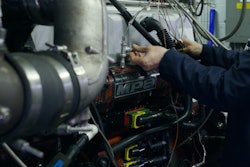Coolant is generally the most neglected fluid on a truck, and it leads to significant woes downstream.
In fact, Lawrence Wong, product technical specialist for Chevron Lubricants, said about 40% of engine related problems can be tied back to the coolant system, and he advocates that carriers add the coolant system to their preventive maintenance cycle.
"There are two quick things you can to check for. One of them is the pH and the other is freeze point. If one or both of those parameters are off, something's wrong with the fluid and you may want to have a sample pulled and tested at a lab just to make sure," he said. "Once those two checks are done, make sure your cooling system is topped off with the appropriate coolant."
Brad Jordan, OEM Technical Services Manager with Shell Global Solutions, said maintenance is relatively simple for extended life, or Organic Acid Technology (OAT), coolants. "Fleets should check the condition of their coolant at least twice a year. With colder weather coming, the fall is a good time," he said.
First, Jordan recommended fleets perform a visual check of the coolant level and appearance. The coolant should be clear with no cloudiness, floating debris or oil visible.
The freeze point, Wong said, should be checked with a refractometer, which is more accurate than a ball/float hydrometer. The "ball float" is popular because it's inexpensive, but Wong said a good refractometer, which offers much better insight into coolant condition, can easily be found for $50 or less, and fleets can even ask their coolant suppliers to provide one.
"The coolant ball/float gauge can be very inaccurate as the balls will, over time, absorb glycol, which changes their weights and will affect the results given," added Paul Cigala, commercial vehicle lubricants application engineer for ExxonMobil. "Refractometers, either manual or digital, give the most accurate freeze point results of the new and in-service coolant."
An approximately 50/50 mixture of water to coolant should provide free protection of minus-34-degrees Fahrenheit.
If the level is low, but otherwise the coolant is in good condition, Jordan said it is best to top off with premixed 50/50 coolant of the same type/brand. "Traditional Inorganic Additive Technology (IAT) or fully formulated coolants take more work," he noted. "The additives in these type of coolants deplete over time and need to be replenished regularly with supplemental coolant additives (SCAs). The specific maintenance depends on the exact type/brand of coolant and the fleet needs to follow the coolant manufacturers guidance."
Coolant is designed to handle a wide temperature range. A 50/50 mixture (assuming the coolant is in good condition) should ensure protection in extreme summer heat and the coldest winter days, Jordan said, adding that a 50/50 mix protects down to -34°F / -37°C with boil-over protection up to 264°F / 129°C (with the use of a 15 psi pressure cap) – plenty of range to make that run from Rio Grande Village to Berthoud Pass.
For especially cold climates, it may be necessary to go with a 55/45 mixture of coolant to water, or even 60/40 mixture, and it might require a top off with concentrated coolant to get the freeze point right, but Cigala cautioned that balancing the two liquids is key. While higher glycol content of the coolant will decrease the coolant’s freeze point, he said it will also decrease heat dissipation from the engine and eventually cause overheating issues.
"(Water) is really efficient at moving heat away from the engine and keeping it cool," Wong added, noting that overheating may not be as much of an issue in the dead of winter, "but when we get through winter and transition back to summer, that could become something to watch for."
If the freeze point is too low, Jordan said it is important to use distilled or deionized water to make adjustments as poor quality water can cause issues with scale and corrosion.
While most coolants are compatible, there is a risk that using two different coolant chemistries could dilute the concentration of each of those additive technologies to the point that neither is able to provide sufficient corrosion protection. Wong noted, "definitely don't mix conventional [coolant] with extended life," because mixing the two can cause the silicate in the conventional coolant can react with extended life coolants, causing gelling and the build of deposits leading to blockages.
A fleet should flush and refill with a quality premixed 50/50 extended life coolant when the coolant has become contaminated. Debris, cloudiness, changes in color (possibly due to rust), or visible oil are all indicators that it is probably time to flush your cooling system, Jordan said.
"There are also test strips or even labs that can test coolant samples to see if they are suitable for continued use. These indicators could be evidence of mechanical issues that have allowed oil to get in the coolant, or from topping off with dirty water, or even topping off with another type of coolant," he added.
Cigala said elevated metals in the analysis are also an indicator of additive depletion and a decline in the coolant’s protection capabilities and advised fleets to use TMC RP 368 – Proper Coolant Draining and Filling Procedures for Heavy Duty Diesel Engines for guidance when draining and refilling the coolant system once the system is properly flushed of all rust and contaminants.












